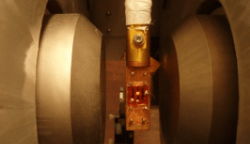New OLED Spins Brighter

Physicists at the University of Utah (USA) have invented a new ‘spintronic’ organic light-emitting diode (OLED) with the potential to be brighter, cheaper and more environmentally friendly than existing LEDs. They made a prototype of what is called a spin-polarized organic LED, or spin OLED, that emits orange light. In time the new technology could be extended to emit red and blue light, and possibly even white light. It may take a while for the new LEDs to go commercial, because they only operate at cold temperatures (-33 °C), so more work is needed to develop practical devices.
The new OLED is based on spintronic devices, which utilise the spins of electrons in a semiconductor material to store or gate data. The researchers discovered that with key advances in the organic semiconductor material, spin valve devices could also be made to emit light. The first advance is to use deuterium (‘heavy hydrogen’) instead of normal hydrogen in the organic layer, which increases efficiency. The second advance is to deposit an extremely thin layer of lithium fluoride on the cobalt electrode, which allows electrons to be injected on one side of the spin valve while holes are injected on the other side. This makes the spin valve bipolar, unlike older spin valves which only allow hole injection.
The ability to inject electrons and holes at the same time is the key to light emission. When electrons and holes collide in the material, they combine to neutralise each other and release their energy in the form of light. Additionally, dual injection of electrons and holes allows the device to carry more current and therefore emit more light.
The intensity of the light emitted by the new spintronic OLED can be controlled by a magnetic field, unlike older OLEDs which require more current to increase brightness. Future versions of the new spin OLED could also allow the colour to be varied by changing the magnetic field, unlike conventional OLEDs, which emit light at a particular colour depending on the semiconductor material.
